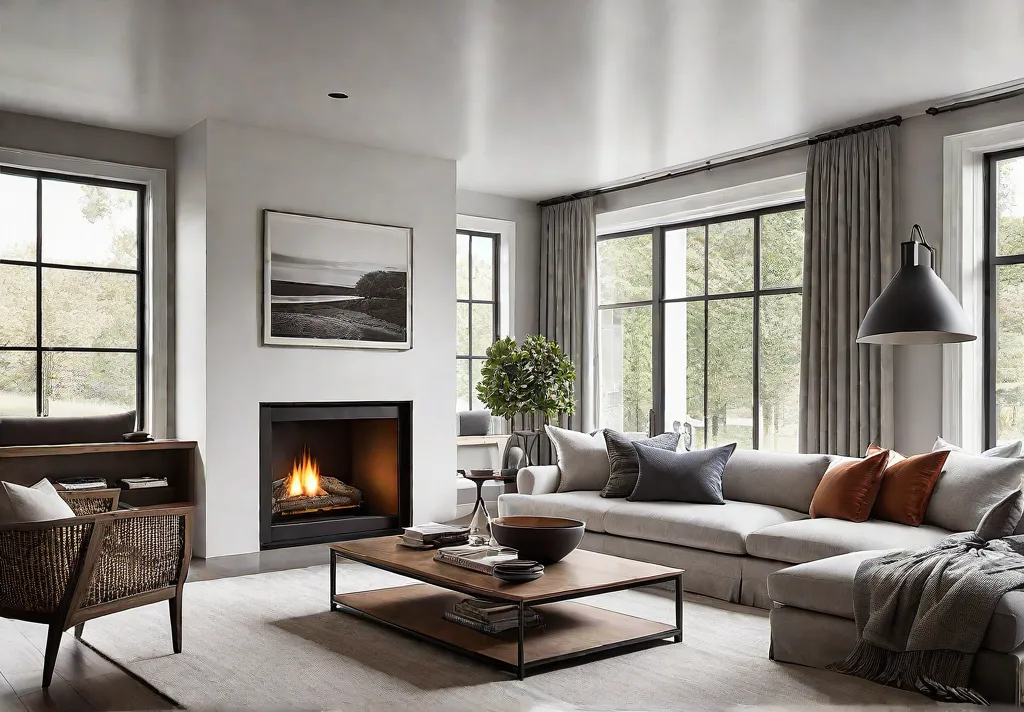Hey there, decor mavericks! It’s your girl Jessica, back with another juicy guide to help you slay that living room layout. Let’s be real – creating a functional and fabulous living space ain’t no cakewalk. But with my tried-and-true tips, you’ll be serving up some serious #livingroomgoals in no time.
We’re talking strategic furniture placement, traffic flow optimization, and brilliant small-space solutions that’ll make you live large in even the tiniest cribs. So grab your pencils and prepare to take notes because this masterclass is about to get wild!

Assessing Your Living Room
As an expert in home decor, I can’t emphasize enough the importance of thoroughly assessing your living room before diving into layout planning. This crucial step lays the foundation for a functional and visually appealing space.
Measuring and Mapping Your Space
Let’s start by getting down to the nitty-gritty details. Grab a tape measure and jot down the room’s dimensions, including nooks, alcoves, or awkward angles. Don’t forget to note the locations of windows, doors, and architectural features like fireplaces or built-ins. With these measurements in hand, create a scaled floor plan – this will be your canvas for experimenting with different furniture arrangements.

Understanding Traffic Patterns
Now, it’s time to observe how people move through the space. Identify high-traffic areas and potential bottlenecks. Trust me, you don’t want your guests playing a real-life game of “The Floor is Lava” as they navigate around poorly placed furniture. Pay close attention to the natural flow from entrances to seating areas and vice versa.
Identifying Focal Points and Natural Light
Every living room deserves a showstopper – a focal point that draws the eye and sets the tone for the entire space. This could be a stunning fireplace, a large picture window, or even a statement piece of furniture. Equally important is maximizing natural light, as it can instantly make a room feel more spacious and inviting.
While the average living room size in the US is 234 square feet, don’t let numbers fool you. Traffic flow can significantly impact a room’s perceived spaciousness, so be mindful of how you arrange your furniture.

One practical tip: Observe how people naturally move through the space to identify high-traffic areas and leave ample room for comfortable navigation. Remember, architectural features like windows and doors can influence furniture placement, so work with them, not against them.
Avoid the common mistakes of cramming too much furniture into a small space or blocking natural light sources. A cluttered, dark living room is not everyone’s idea of a cozy retreat.
The key takeaway? A thorough assessment is the foundation for a successful living room layout. Understanding your space’s limitations and opportunities is crucial before you start moving furniture around like a madwoman.
Speaking of furniture placement, that’s our next topic…
Furniture Placement Strategies
As an expert in home decor, I can’t stress enough the importance of strategic furniture placement. It’s the key to maximizing your living room’s potential and creating a harmonious, functional space.

Optimizing for Small Space Living
Let’s face it: not everyone has the luxury of a sprawling living area. But fear not, my friends! Even the tiniest of spaces can feel open and inviting with a few clever tricks. The golden rule? Prioritize functionality and comfort over sheer size. Opt for multifunctional, compact, multi-functional pieces for more than one purpose, like sofa beds or storage ottomans. And don’t be afraid to get creative with vertical space – wall-mounted shelves and hanging planters can work wonders!
Creating with Multi-Functional Furniture
Ah, the beauty of multi-functional furniture. Pieces are a small-space dweller’s best friend. A sleek sofa bed can double as a cozy guest bed, while a storage ottoman offers a place to rest your feet and stash away clutter. And let’s not forget about those nifty lift-top coffee tables—perfect for concealing remotes, magazines, and other living room essentials.
Defining Conversation Areas
Now, let’s talk about creating cozy conversation areas. The ‘golden triangle’ rule suggests placing seating options within proximity for optimal conversation flow. But don’t just plop your furniture against the walls—angle it slightly inward to encourage a sense of intimacy. Consider using a large rug to define the seating area and anchor the furniture pieces for those tight quarters.

Remember, strategic furniture placement isn’t just about making the most of your square footage – it’s also about enhancing your living room’s overall aesthetic and ambiance. So have fun with it, experiment with different layouts, and don’t be afraid to get a little creative!
Ah, but our journey doesn’t end here. Next, we’ll explore optimizing traffic flow, ensuring your living room is as functional as fabulous.
Traffic Flow Optimization
As a home decor enthusiast, I can’t emphasize the importance of optimizing traffic flow in your living room enough. A well-planned layout enhances functionality and contributes to the space’s overall ambiance.

Choosing Furniture for Optimal Flow
When selecting furniture pieces, consider their size and shape. Opt for streamlined designs with rounded edges to create a smoother flow. Bulky, sharp-cornered pieces can disrupt the natural movement and make the room feel cramped. I love the sleek lines of mid-century modern furniture – they add a touch of sophistication while promoting seamless navigation.
Creating Designated Walkways
Establishing clear pathways is crucial for a well-organized living room. Main walkways should have a minimum of 36 inches of clearance, ensuring comfortable movement. Use area rugs strategically to define these pathways and separate functional zones visually. I like experimenting with contrasting rug patterns or textures to add depth and interest to the space.
Furniture Arrangement for Flow
Arrange your furniture to create a circular flow around the room. This not only facilitates movement but also encourages conversation and interaction among guests. Avoid placing pieces in a way that obstructs pathways or creates awkward bottlenecks. I recently rearranged my living room to achieve this continuous flow, and the difference is remarkable – it feels so much more inviting and welcoming.

Smooth traffic flow is essential for a comfortable and functional living room. By carefully considering furniture placement and creating designated walkways, you can enhance the overall ambiance and make the space more open and inviting.
In small or oddly shaped living rooms, getting creative with furniture arrangement and utilizing multi-functional pieces of multifunctional anger. For instance, a sleek console table can double as a workspace or a bar cart, while a compact loveseat can provide additional seating without overwhelming the space.
Small Space Living Solutions
As an expert in home decor and gardening, I understand the challenges of making the most of a small living room. Fear not, my friends! We can transform even the tiniest of spaces into a functional and stylish oasis with a few clever tricks.

Creative Storage Solutions
Let’s start by tackling the ever-present clutter monster. Vertical space is your new best friend! Embrace those lofty ceilings and install floor-to-ceiling bookshelves or wall-mounted cabinets. Not only will they provide ample storage, but they’ll also add a touch of visual interest to your cozy abode.
Let’s not forget the humble ottoman—a true multitasker in the small-space game. Look for ottomans with hidden storage compartments, perfect for stashing away those pesky throw blankets or board games when not in use.
Wall-mounted and Foldable Furniture
Ah, the age-old dilemma: how to fit all the necessary furniture without making your living room feel like a cramped maze? Enter wall-mounted and foldable furniture! Murphy beds are a godsend for tiny apartments, disappearing into the wall when not in use. And for those cozy dinner parties, consider a drop-leaf table that can be folded down when unnecessary.

But why stop there? Get creative with wall-mounted desks, shelves, and even televisions! Not only will they save precious floor space, but they’ll also add a touch of modern flair to your abode.
Let’s explore the world of multi-functional furniture – a true game-changer for small-space living.
Multi-Functional Furniture Ideas
As a space-savvy homeowner, I advocate for multi-functional furniture that can seamlessly transform and adapt to your ever-changing needs. When every square foot counts, investing in versatile pieces that can serve multiple purposes without compromising on style or comfort is crucial.

Investing in Convertible Furniture
Convertible furniture is the ultimate space-saving solution that allows you to transition between different living scenarios effortlessly. From sofa beds that can double as guest beds to coffee tables that transform into dining tables, these innovative designs are a game-changer for small spaces. Not only do they provide flexibility, but they also often feature sleek and modern aesthetics that complement any décor style.
Utilizing Furniture with Hidden Storage
Storage is a constant battle in compact living spaces, but fear not! Furniture with hidden storage compartments is here to save the day. Ottomans with removable lids, benches with built-in shelves, and coffee tables with concealed compartments are just a few examples of how you can seamlessly incorporate storage without sacrificing valuable floor space. These pieces are the unsung heroes of organization, allowing you to declutter while maintaining a streamlined and cohesive look.

Maximizing Functionality with Versatile Pieces
Beyond convertible and storage-savvy furniture, numerous other multi-functional options exist, such as a console table that can double as a desk or a sideboard with adjustable shelves that accommodate various display items or storage needs, the key is to evaluate your lifestyle and prioritize pieces that can adapt to your ever-changing requirements.
As we transition to the conclusion, remember that maximizing your living room layout is all about striking the perfect balance between functionality and aesthetics. Multi-functional furniture is a powerful tool in achieving that harmonious blend.
Wrapping Up
There you have it, my decor darlings – the ultimate blueprint for conquering your living room layout like a boss! By assessing your space, optimizing traffic patterns, and getting creative with multifunctional furniture, you can transform even the most awkward or cramped room into an oasis of style and comfort.

But the real key? Have fun with the process! Don’t be afraid to experiment, mix things up, and let your unique personality shine through. After all, your living room should reflect your quirky, one-of-a-kind spirit.
So go forth, my fearless decor warriors, and confidently slay those living room woes. And remember, if you ever need a pep talk or a fresh set of eyes, your girl Jessica is just a click away. Let’s get out there and make some serious living room magic happen!






